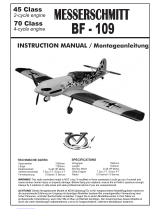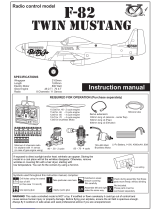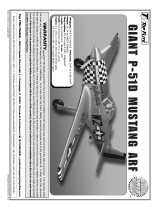vq VQA049 User manual
- Category
- Remote controlled toys
- Type
- User manual
This manual is also suitable for

90 Class
2-cycle engine
4-cycle engine
INSTRUCTION MANUAL
RADIO CONTROLED ALMOST READY-TO-FLY ENGINE POWERED ALL BALSA PLANE
Wingspan approx. 61.8 in. (1570mm)
Fuselage length approx 48.8 in. (1240mm)
6.4 lb.
(2900g)
.61
.90
6 ch.
WARNING!
This radio control model is not a toy. If modified or flow carelessly it could go out of control and cause
serious bodily injury or property damage.
Before flying your airplane, ensure the air field is spacious enough.
Always fly it outdoors in safe areas with no debris or obstacles.
Kg
or electric equivalent.
cu.in.
cu.in.
VQA048 / VQA049
KAWASAKI
Ki-61 Hien “Tony”
60 Class
10V (40A)
AEROMODELLO RADIOCOMANDATO

1.5mm
AB
!
CA
L/R
Assemble left and right
sides the same way.
X
Drill holes using the stated
size of drill
(in this case 1.5 mm Ø)
Use epoxy glue
Take particular care here Hatched-in areas:
remove covering
film carefully
Not included.
These parts must be
purchased separately
Check during assembly that these
parts move freely, without binding
Apply cyano glue
The pre-covered film on ARF kit may wrinkle due to variations
of temperature. Smooth out as explained right.
* Use an iron or heat gun. Start as low setting. Increase the
setting if necsessary. If it is too high, you may damage the
film Low setting
SILICON
EPOXY A
EPOXY B
CA
GLUE
Epoxy Glue ( 5 minute type)
Silicon sealer
Cyanoacrylate
Glue
Minimum 6 channel radio for airplane
with 6 servos (EP version) and
7 servos (GP version)
.90 - 4 cycle
12x6 for .60 - 4 cycle engine
13x7 for .90 - 4 cycle engine
14X8 for Quantum 4120/07
Silicone tube
Extension for aileron
servo, retract servo.
.60 - 2 cycle
REQUIRED FOR OPERATION (Purchase separately)
Linkage Stopper x2
(for retract servo)
Epoxy Glue (30 minute type)
TOLLS REQUIRED
Hobby knife
Needle nose Pliers
Phillip screw driver
Awl
Scissors
Wire Cutters
(Purchase separately)
Hex Wrench
.........................................................
.........................................................
.........................................................
.........................................................
.........................................................
.........................................................
.........................................................
.........................................................
.........................................................
.........................................................
.........................................................
Sander
Masking tape - Straight Edged Ruler - Pen or pencil - Rubbing alcohol - Drill and Assorted Drill Bits
Read through the manual before you begin, so you will have an overall idea of what to do.
Symbols used throughout this instruction manual, comprise:
(Purchase separately)
Retract landing
gear VQAR010
Retract servo
x1
.Motor control x1(GP version)
.Aileron x2 .Elevator x1
.Rudder x1 .Flap x 2
Quantum 4120/07
Brushless Motor
or equivalent.
Phoenix-60 Brushless
Motor Control or equivalent.
Li-Po Battery, 14.8V, 4000mAH, 80A
CONVERSION TABLE
1.0mm = 3/64”
1.5mm = 1/16”
2.0mm = 5/64”
2.5mm = 3/32”
3.0mm = 1/8”
4.0mm = 5/32”
5.0mm = 13/64”
6.0mm = 15/64”
10mm = 13/32”
12mm = 15/32”
15mm = 19/32”
20mm = 51/64”
25mm = 1”
30mm = 1-3/16”
45mm = 1-51/64”

AB
2- Joining the wing
AB
Draw the center line
on the wing joiner
- Trial fit each part before gluing . Be certain that there are no gaps.
If the parts will join, but with a gaps, sand or trim the parts a little at
a time until the parts meet exactly with no gaps.
- Check for the correct dihedral angle
Before gluing:
- Draw the center line on the wing joiner.
1-Aileron extension cord installation
WING BOTTOM-VIEW
Using the thread (pre-installed at factory)
to slide the aileron and flap extension cord
into the wing half.
Using the adhesive tape to secure
the one end of the aileron and flap
extension cord in place.
Using the adhesive tape to secure the one
end of the aileron and flap extension cord in place.
X
30cm Extension cord
Thread
Adhesive tape
Adhesive tape
WING BOTTOM-VIEW
WING TOP-VIEW
30 min. Epoxy
Coat one half of the dihedral brace with epoxy up
to the center line. Install the epoxy-coated side of
the dihedral brace into the wing joiner cavity up to
the center line.
Aileron servo hatch
Turn the screws and full the aileron and
flap servo hatch out of the wing half.

Cut away only
the film
TOP-VIEW
A
B
C
BC
A
CENTER
WING
SECTION
CA
CA
CA
CA
BOTTOM
Retract servo tray
Retract servo mount
Retract servo mount “B”is longer than “C”
Note:
TOP-VIEW
CENTER
WING
SECTION
BOTTOM
Retract servo
Retract servo
X
Install the retract servo onto the retract
servo mount and secure it in place with
four screw (included with radio set).
Note: The head of servo should be positioned
toward the rear of the wing.
RETRACT SERVO INSTALLATION
ABC
Retract servo tray Retract servo mount
Carefully slide the wing halves together,
ensuring that they are accurately aligned.
Firmly press the two halves together,
allowing the excess epoxy to run out.
Note: The two wing halves roots must
fit together perfectly.
Clear off the excess epoxy.
! Make sure to glue securely, If not properly glued,
a failure in flight may occur.
Glue must go inside
Wing joiner
Glue
Wing half
Hold the wing halves together with paper
clamp and rubber band.
IMPORTANT:
Please do not clean off the excess epoxy on the
wing with strong solvent or pure alcohol, only use kerosene to
keep the colour of your model not fade.
AB
AB
30 min. Epoxy
WING TOP-VIEW
Rubber band
(not include)
Paper clamp
(not include)
Nylon wing bolt
(included)
WING TOP-VIEW
3- Joinning the wing
AB
AB
30 min. Epoxy
WING TOP-VIEW
4-Retract servo mount
5- Retract servo

BOTTOM VIEW
RETRACTED EXTENDED
Link the servo and retract gear arm with push rod. Be sure to adjust the stroke so that the landing gear locks in both up
and down position.
With the retract and retract servo in the retracted position, mark the position
where each of the pushrod will attach to the servo arm, a small piece of
masking tape works well for this. Cut off the excess length each rod.
Plastic strap
Main landing gear
Gear mount
(plywood)
Ply gear mount
plate
Square plastic
3x20mm
3x20mm
Ply gear mount plate
Square plastic
Main gear (left)
Main gear (right)
Gear mount
(plywood)
Plastic strap
3x20mm screw..16
L/R
3x15mm viti
..........8
X
5/64”
2mm
12
STEP STEP
Note: Struts and retract not included.
3x15mm
..........8
3
STEP
X
6- Retract and struts
7- Retract linkage
8- Fixed gear
BOTTOM VIEW

Plastic control horn
Included with the
radio set
Aileron servo
hatch (ply 3mm)
Aileron servo
extension
cord
5/64(2x15mm)
screw
11- Aileron servo
X
....................4
......4
5/64”
5/64(2x20mm)
screwi
2mm
BOTTOM VIEW
......4
2x15mm
2x20mm
Installing the aileron servo on to the hatch (side-view)
Aileron servo Hatch
Servo mount
WING BOTTOM
AIL.
L/R
3x12mm screw
ABS gear cover
L/R
1.5mm
ABS gear cover
2x6mm
screw
Gear mount
(plywood)
3x12mm screw
2x6mm screw
..........4
..........8
CA
ABS gear strap
9- Fixed gear
BOTTOM VIEW
10- Fixed gear ABS wheel well cover (for fixed gear)
BOTTOM VIEW
CA
L/R

BOTTOM VIEW
L/R
X
1.5mm
2x10mm
Flap servo hatch
Servo mount
Flap servo hatch
Aileron servo hatch
X
Aileron extension cord
Installing the flap servo on to the hatch (side-view)
Flap servo Hatch
Servo mount
FLAP
Aileron extension cord exit X
flap extension
cord
Flap pushrod
exit
...........4
4
5
Connector
WING BOTTOM
Pushrod exit hole
FLAP
BOTTOM VIEW
12- Aileron and flap linkage
L/R
13- Aileron and flap linkage

Securely glue together. If coming off during flight,
you lose control of your air plane.
Trial fit each part before gluing . Be certain that there
are no gaps. If the parts will join, but with a gaps, sand
or trim the parts a little at a time until the parts meet
exactly with no gaps.
When joining the stabilizer it is extremely important to
use plenty of epoxy (30 minutes) or CA glue (thin type)
AB
A = A’
B = B’
C = C’
2x20mm screw
AA’
AB
Apply the epoxy
both side
14- Vertical / Horizontal stabilizer
BB’
CC’
Cut away only the
covering both side
Cut away only the
covering both side
AB
2x20mm screw
2.mm
5/64”
Allow the epoxy to cure before proceeding to the next
step.
XThrottle servo
Rudder servo
X
Elevatorservo
15- Servo
NOTE: Place of throttle servo may be change
depend of engine (Four-stoke or two-stroke engine)
Switch hole
BOTTOM VIEW
10mm
Plastic control horn
....................3
......4
......2
2x20mm(EL)
2x30mm(Ru)
Apply a thin layer of machine oil or petroleum jelly to only the
pivot point of the hinges on the elevator, then push the elevator
and its hinges into the hinge slots in the trailing edge of the
horizontal stabilizer. There should be a minimal hinge gap and
the end of the elevator should not rub against the horizontal
stabilizer.
When satisfied with the and alignment, hinge the elevator to the
horizontal stabilizer using 5 minute epoxy. Make sure to apply a
thin layer of epoxy to the top and bottom of both hinges and to
inside the hinge slots. Repeat the previous procedures to hinge
the second elevator to the other side of the horizontal stabilizer.
Hinge
Petroleum jelly
STABILIZER

16- Linkages
2mm screw
Throttle
pushrod
Connector
Connector
...........2
............3
Elevator push rod
Elevator push rod
Rudder push rod
Tail wheel push rod
Rudder servo
Elevator servo
Throttle servo
BOTTOM VIEW
Throttle / Rudder servo
2mm screw
Elevator servo
Elevator pushrod
Connector
1- Insert the tail wheel pushrod into the hole on the tail gear control
horn (as show).
2- Install the tail wheel control horn in place.
4- Secure the tail wheel control horn in place using a 5/64”(2mm) screw set,
Ensure smooth non-binding movement.
1
3
4
2
...............1
Tail landing gear
..........1
............1
2x3mm screw
.................1
Tail wheel control-
horn
2mm I.D collar
3- Instal the tail wheel gear in place.
BOTTOM-VIEW
17- Tail gear

(110 ~ 113mm)
! Engine thrust on bulk-
head is already adjust
at factory
1.5
TOP-VIEW
1-Position the engine on the engine mount beams so the
distance from the prop hub to the fire wall is 110mm.
2-Mark the engine mounting plate where the four holes
are to be drilled.
3-Remove the engine and drill 1/8”(3mm) hole through
the beam at each of the four marks made above.
Note: Engine thrust on balk head
is already adjust at factory
! Align the mark on both mounts
with the mark on the fuselage
2-Remove the engine mount and drill a 3/16”(5mm) hole
through the fire-wall at each of the four marks made above.
3-Attach the four blind-nut to the fire-wall as show.
1-Using a pencil or felt tipped pen, mark the fire wall where
the four holes are to be drilled.
4-Reposition the engine mounts on to the
fire-wall and secure them with four
5/32x1”(4x25mm) screws.
A
B
B’
B=B’
FRONT-VIEW
FRONT-VIEW
...4
.................4
4x25mm screw
Blind-nut
5mm
13/64”
A
3mm
18- Engine mount
19- Engine installation

With side silencer
21- Engine installation
(IN CASE OF 2T ENGINE)
With hang silencer (Pitts-style) With hang silencer (Pitts-style)
(110 ~ 113mm)
4.3 ~ 4.4”
TOP-VIEW
-Reposition the engine on the mounting beams , aligning it with
the holes drilled. Insert one 3x25mm screw through each
of the mounting holes. Apply silicon (Blue-Locktile 242) to each
of the 3x25mm screw and firmly secure the engine to the engine
mount using four 3mm nuts.
20- Engine installation

X
To muffler
Filler tube
To engine
Rubber
stopper
Cap
Stopper
FUEL TANK INSTALLATION
Fuel tube
22- Fuel tank
After confirming the direction . Insert this assembly, clunk end first, into the
fuel tank and tighten and screw the fuel tank cap on firmly.
Board
Adhesive
tape
Cut the opening
Attach the board or transparent plastic on the side of
the fuselage with the adhesive tape as show.
Using a pencil or felt tipped pen trace around the engine
head where it meet the cowl. Cut the opening the board
or transparent plastic for the engine head as marked
above.
109 - 111mm
(4-21/64”)
5x70mm bolt.
(Bolts, nuts and washer are not supplied)
Firewall
A
A’
A=A’
FRONT-VIEW
SIDE-VIEW
B=B’’
TOP-VIEW
B
B’
Checking for leaks - block the vents and blow into the feed.
if in doubt submersing the tank in a blow of water will show
up any problems.
Blow
Water
23- Electric motor
24- Cowling

2mm
25- Cowling
1~2mm
Board
Remove the engine and insert the cowl on to the fuselage
so the distance from the fire wall to the front of the cowl is
109 to 111mm
Remove the cowl from the fuselage and carefully cut the
opening for the engine head as marked above. Do the
same way with the hole for needle-valve.
Again. Insert the cowl on to the fuselage and secure it in
place with five 2.5x10mm screws.
(4-21/64”)
111mm
Ruler
Cut the opening
Again. Insert the cowl on to the fuselage and secure it in
place with four 2.5x10mm screws.
26- Machine guns
4mm
AB
2.5x10mm.....4

4mm O nylon tube
3mm O nylon tube
CA
CA
28- Decor
Sticker (yellow)
9.25”(235mm)
21.25””(540mm)
(Black)
(White)
4mm
5/32”
4mm
5/32”
BOTTOM-VIEW
29- Tail gear cover
12mm
Cut away the covering
inside before install the
air scoop and wing cover.
Plastic air scoop
CA
6x50mm nylon bolt
6X50mm bolt
...2
Using the ABS air scoop as a template,
trace around the outside edge of the
ABS air-scoop and then remove it.
Using a sharp hobby knife, cut away
the covering inside the lines. Not to cut
into the wood.
Apply the ABS air scoop in place and secure
them with CA glue.
27- Air scoop
Bottom view
15/32”
Plastic wing cover
2x10mm.....6
1mm
3/64”
Plastic tail gear cover

31- Balance
4 ~ 4-1/8”
(100 ~ 105mm)
15/64”(6mm)
13/32”(10mm)
13/32”(10mm)
1-23/64””(35mm)
30- Sticker
Sticker
32- Control surface
AILERON STROKE
ELEVATOR STROKE
RUDDER STROKE
Sticker
Note: Adjust the location of the battery pack to achieve this C.G location.
DO NOT try to fly an out-of balance model!
1-23/64””(35mm)
15/64”(6mm)
Adjust the travel of the control surfaces to achieve the values stated in the diagrams.
These value will be suitable for average flight requirements. Adjust the values to suit your particular needs.
IMPORTANT: Please do not clean your model with pure alcohol, only use liquid soap with water or use glass cleaner to
clean on surface of your model to keep the colour not fade.

PRE-FLIGHT CHECKING AND ADJUSTING YOUR MODEL
It is almost impossible to fly your model without checking and adjusting your model. You can stop easily if your
car is not running strait. But you cannot stop your airplane after take off. Your plane could go right or left. Or
even go up or down. Without understanding these instruction before flying the Ki-61, you might otherwise have
difficulty in flying, or crash the plane. If you are new to Radio Control flying, you should not fly the Ki-61 but
have an expert fly it. Even if you are experienced pilot, read this before your first flight.
PRE-FLIGHT CHECK
1-Balance: There is very important relationship between the CG position and stall characteristic of an airplane
or knife-edge performance. An aft CG will make the plane snap roll instead of making a clean stall. And your
plane goes to down side at knife edge flying instead of strait. To measure the CG position, measure 4 ~ 4-1/8”
(100 ~ 105mm) from leading edge ( a + / - 13/64” = 5mm is fine).
2-Check the operation and direction of the elevator, rudder, ailerons and throttle:
ELEVATOR AILERON
RUDDER
Always take off and landing your airplane into the wind.
Adjust the engine always from behind, but never from infront or the sides as rotating propeller may badly injure you.
Do not allow watching people to get too close to a rotating propeller.
Ensure the spinner and propeller are securely attached. Immediately disure defective propeller as well as deformed
spinners.
CAUTIONS FOR SAFETY
Fully extend the transmitter and receiver antenna.
Switch off the transmitter and receiver after landing.
Ensure the airfield is spacious enough.
Do not fly your airplane above people standing around.
WARNING
Do not put in a large-than recommended engine. A bigger engine does not necessarily mean better performance.
BEFORE FLYING CHECK EVERYTHING
Before each flight, inspect the airplane for any loose parts. Check the hinges, make sure the pushrods are still firmly
attached, and check the engine mounting bolts. In general, check everything on the plane that might possibly come
loose.
CHECK THE FREQUENCE BEFORE FLYING
DO NOT FLY NEAR A POWER LINE
The power lines cause radio interference, so avoid flying near them.
-
 1
1
-
 2
2
-
 3
3
-
 4
4
-
 5
5
-
 6
6
-
 7
7
-
 8
8
-
 9
9
-
 10
10
-
 11
11
-
 12
12
-
 13
13
-
 14
14
-
 15
15
-
 16
16
vq VQA049 User manual
- Category
- Remote controlled toys
- Type
- User manual
- This manual is also suitable for
Ask a question and I''ll find the answer in the document
Finding information in a document is now easier with AI
Related papers
Other documents
-
GREAT PLANES GPMA1154 Owner's manual
-
 VQ Models Messerschmitt BF-109 User manual
VQ Models Messerschmitt BF-109 User manual
-
Horizon Hobby Ultra Stick Lite Assembly Manual
-
 VQ Model F-82 TWIN MUSTANG User manual
VQ Model F-82 TWIN MUSTANG User manual
-
 Top Flite TOPA0700 Owner's manual
Top Flite TOPA0700 Owner's manual
-
Black Horse Model A6M ZERO Instruction Manual Book
-
Black Horse Model BH149 User manual
-
Phoenix P51 mustang 60CC User manual
-
Black Horse Model MESSERSCHMITT BF-109E BH146 User manual
-
Black Horse Model BH36 User manual


















